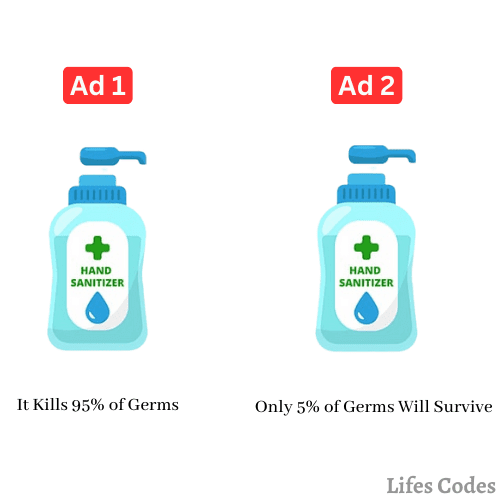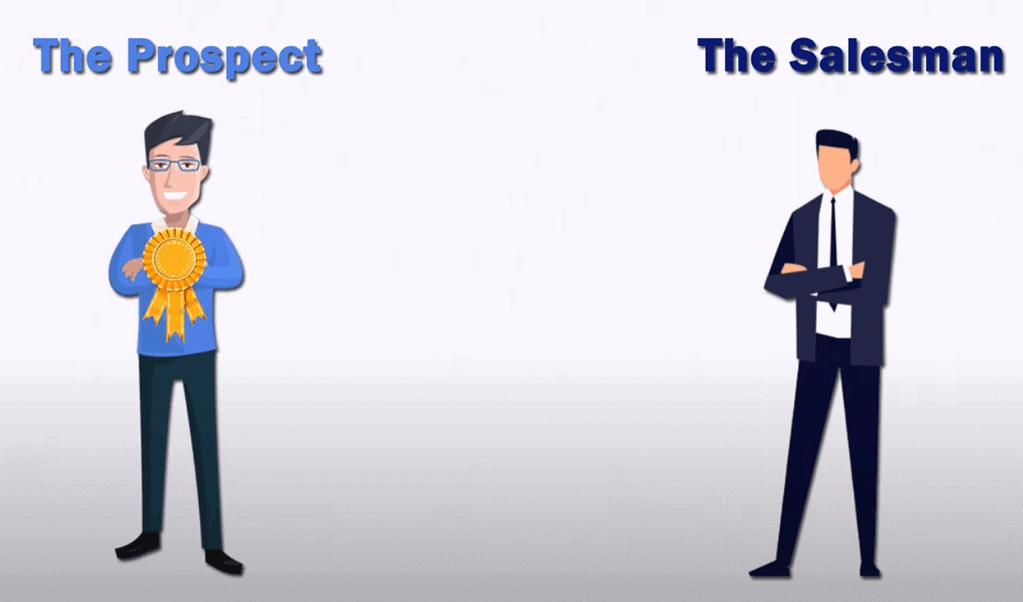Last Updated on November, 2023 by Edison
The following is the script of my YouTube video. If you are a visual learner you might find watching the video more helpful.
Selling is one of the most valuable skills you can acquire today.
Even if you have a great product or idea, if you cannot convince other people, you won’t generate revenue or impact the world.
Here, I’ll talk about the psychology of selling.
You will learn specific strategies that will transform your communication and selling abilities.
Let’s start with the personality type.
People think a salesman is sociable and assertive – or an extravert.
However, a study by Adam Grant showed that the most effective salespeople are actually ambiverts.
Ambiverts are assertive and enthusiastic enough to persuade and close a sale, but they also listen carefully to customers and avoid coming across as being too confident or excited.
The good news is that most of us are ambiverts.
If you don’t fall into this personality type, it’s not a big problem because… If you are an introvert, you can learn to be more outgoing.
And if you are an extrovert, you can learn to listen.
Framing
Framing is when people react differently to the same information because of how it is presented. Advertisers have known this for a long time.
For example, we see two ads for hand sanitiser. Which one is more persuasive?

Despite conveying the same message, the first ad is more appealing.
This is because framing influences how people perceive an idea. So, you want to be careful about how you frame the solution you’re selling.
You also need to consider the dynamic between the prospect and the salesman.
The prospect might frame himself as a prize to be won because he has the money. They will price-shop you, complain, and talk in a demeaning manner.
At the same time, many beginner salespeople make the mistake of thinking that the customer is a price to be won.

They will try too hard to please them, and this behavior dramatically lowers their status in that situation.
It’s important to understand that a great salesman does not look like a salesman.
And we do not hold salespeople in high regard as a society, but we abdicate responsibility to people we think are experts even though they might not be.
That’s why you want to be seen as an advisor who brings new ideas.
You know they have a problem that’s causing them pain.
You know that it will get worse if they don’t do something about it.
And you have a solution that can solve their problem efficiently.
They are not a prize to be won; your service is.

With that in mind, let’s move on to the next concept.
Internal Monologue
As you talk to the prospect, they are talking to themselves.
Agh, a salesman
I don’t have time to hear a sales pitch right now
Hmm, this makes sense
This doesn’t make sense at all
How can I politely tell him to fuck off!
This internal dialogue is fueled by their beliefs about your company, industry, or salespeople in general.
These beliefs are formed because of similar experiences.
For example, they might have been tricked by a salesman before, and now they unconsciously attach those negative feelings to you.
Another source of their beliefs is how they were taught while growing up, such as:
- Salespeople will try to trick you.
- All they care about is making money.
- If it sounds too good to be true, it probably is.
- Do not trust people.
Simply put, their brain will automatically look at the situation from a negative point of view.
It’s important to consider their beliefs and objections against buying from you.
Figuring this out might be tedious, but it will save you lots of headaches along the road because instead of banging your head against the wall with high-pressure tactics… you follow a more elegant approach where you pull them to your way of thinking.
Like in Judo, where you use the opponent’s strength against them.

You make the presentation in a way that you deal with objections before they even have the chance to bring them up. And when it’s time to ask for the order, it will be much easier to overcome their objections because you have been lowering their resistance strategically.
Universal Objections
Now, there are only five universal objections you need to consider:
- No Time
- No Interest
- No Difference
- No Trust
- No Decision
No Time
As I said earlier, one of the things people automatically feel is, “I don’t have time. I should think of an excuse to get out of this.”
They think it’s not worth listening to you… That you don’t have something valuable to offer.
According to a study, you have 7 seconds to make a great first impression and earn your right to continue the conversation.
So, you should practice as much as possible to nail the introduction.
Here’s an example:
Hi, is John there?
[enthusiasm, put a smile on your face]
Hi John, my name is Bill Ham? Calling from Sky Digital in Los Angeles? How are you doing today?
Here we phrase the statements as questions and sound like he knows us.
In that instant, their brain goes into search mode, “Should I know this person?” For a few seconds, their internal monologue is not working against you.
Great. You’ve probably heard of us; we’re one of the fastest-growing marketing agencies in California – helping small business owners fix their online marketing.
Now, the reason for the call today is that we have an idea that will triple your revenue in 3 months.
This is a strong opening – We convey enthusiasm and intrigue with our tone of voice. And we present the company as an authority in the industry.
We are also addressing an urgent problem they have. You know, every business owner struggles with driving traffic to their site.
So we are transmitting, “I have a solution to your problem. So why wouldn’t you take the time to listen to it.”
Then we ask questions to get them to talk more about their problem, which is how we anticipate the no Interest objection.
No Difference
During the presentation, you briefly explain your solution and what makes you different from others. But you don’t go into specifics; you must save the best arguments when they start giving objections.
For example,
Here at Sky Digital, we ensure that when someone searches for “best cleaning services” in your area, you show up on the first page of Google. Basically, receiving the lion’s share of highly targeted traffic. But that’s one part of the equation. The other part is turning those visitors into customers.
No Trust
Ask yourself a simple question, “Why should he trust you?”
Maybe because…
Your company has been in the business for over 5 years.
You have worked with well-respected brands.
You helped hundreds of other local business owners double or tripled their revenue.
Or, you can include a specific success story.
For example, Mark had a Pizza shop but struggled financially. Then we helped him promote the business on social media, and now the place is buzzing with people every hour of the day.
It’s based on a simple yet effective storytelling template: Problem – Solution – Desired Result.
You can use these little pieces of information throughout the conversation to make him trust you can deliver.
No Decision
It arises because your prospect fears making a decision and wants to “think it over.”
You need to ask more questions to understand what’s holding him back.
He thinks the price is too high! He fears your idea won’t work! Applying the solution might take a lot of energy! He wonders about your guarantee! Or any other uncertainties.
Just keep drilling till you find the real issue.
Ok, these are five major objections or ways for him to walk away from your offer.
We frame our message and responses to close all of these exits.
- No Time – Sound like an expert
- No Interest – Address an issue
- No Difference – Unique promise
- No Trust – Undeniable Proof
- No Decision – Easy to Understood Proposition
Tonality
Another important tool that can help you take control of their internal dialogue is tonality.
It is the secret weapon of influence because your words impact people on a logical level, while tonality impacts them emotionally.
I suggest reading the script multiple times while attaching the correct tonality to certain words and phrases. Carve these words into their minds so they will pay attention to what you want them to.
I have a simple 3-step process that can help you nail any presentation…
The process is Believe, Perceive, and Transmit.
First, we have to believe. You must convince yourself that your product will help people before you convince anyone else.
Next, we have perceiving; just because you believe in your product doesn’t mean you understand how it helps them.
That’s why you need to study your product extensively so you can communicate the real nature of your product.
Consequently, believing in your product and having intimate knowledge will help you align how you really feel and how you talk.
Tonality Patterns
We’ll use the tone of voice to express the following:
Scarcity and intrigue – Humans tend to want things in short supply. Salespeople use it all the time regarding information scarcity or a scarce product.
And scarcity combined with urgency (to do it now) causes people to take immediate action.
For example, say, “I have 16 products left, and they’ll be completely gone forever,” in a normal/neutral tone.
Now say the same sentence but using the tone of scarcity – when you lower your voice to just above a whisper.
The second one has a greater emotional impact.
The reasonable man / No big deal pattern – A good tactic is to ask for permission before presenting an idea or a product.
For example, “You got a minute?”, “Does that sound fair enough” “Just a couple of quick questions so I don’t waste your time.”
Now, most people will agree with your request.
We are both reasonable men, and it’s a reasonable request.
Absolute Certainty – Your voice takes a firmer, more definitive tone showing that you’re absolutely certain about your idea or product.
I care – We use this pattern when we respond with empathy or uncover their pain points.
Implied obviousness – After you have given strong arguments on why they should buy, you can presuppose that not only you’ll deliver, but you can also help them in more ways.
“You’ll make money with this. But what we can make about you in the long term regarding…”
The Closing Pattern – Don’t close with absolute certainty because it shows you don’t care.
Instead, use Certainty + Calmness + Reasonable man.
All I’m asking is this, you give me one shot, and if I’m half right (absolute certainty), believe me (certainty).
(Pause) The only problem you’ll have is that I didn’t call you six months ago to get you started then (calmness).
Sounds fair enough? (Reasonable man)
The Action Threshold
The action threshold is how certain someone needs to be to take action.
Think about it as a big scale with all the positives (reasons to buy) and all the negatives (reasons not to buy)

And you have limiting beliefs about buying, tipping the scale in one way or another.
Remember that we have these beliefs based on what we were taught by people we trust and from past experiences.
Throughout the sale, we have been tipping the scale in our favor. But when we ask for the order, he will likely say no. He’s not fully convinced.
Now, the best way to lower their action threshold is by painting a picture of the great things they will experience if they buy and how easy it is to start.
We all want actions that require very little energy but have big rewards.
Example:
As soon as you start with us, our team of experts will analyze your website and social media channels and develop a strategy tailored to your needs. We do all the heavy lifting – from researching to creating social media content.
So, you can concentrate on the most important thing, improving the quality of your product.
Pain Threshold
The pain threshold is how much pain a person is feeling right now. How urgent is it for them to solve this problem?
If someone is experiencing high levels of pain, they will take action even if they are not sure the product will work.
You can use this element by asking questions at the beginning to discover their pain points.
As the prospect answers, don’t say your product solves their problem.
Just listen and let them feel their pain for a little while. You can amplify their pain and reinforce urgency by asking questions like…
How long has this been going on?
How has it affected your business?
Do you see it getting better or worse?
Why now? What has changed?
You listen to understand why they have this problem and what keeps them from solving it. The key is to express empathy and sincerity.
An effective tool to increase the pain level is through future pacing.
When hearing your idea, he is calculating the downsides in his mind. What’s the worst it can happen if he buys, right?
Well, you frame it differently; what’s the worst it can happen if he doesn’t buy now?
You describe a future of how much pain and money is going to cost him if he doesn’t make a decision.
For example, he might say, “I need to think about it.”
“Look John, thinking about it won’t change the fact that your website does not rank on Google, has serious User Experience issues, and as a brand you don’t have a strong online presence. In other words, you are not taking full advantage of these revenue streams like your competitors are doing. The more you wait, the more you guys fall behind.”
The Fear of Selling
Many people find the idea of selling uncomfortable.
If that person is you, then you need to change your approach.
Start by accepting that you are going to suck at first.
You might have gone through many books, videos, and courses, acquiring as much information as possible to become a great closer immediately.
Knowing how things work, in theory, can speed up the road to mastery. But you’ll learn the most valuable lessons when working as a salesman.
I’ve made this mistake myself. You know, being obsessed with achieving massive results right from the beginning.
I was obsessed with perfection because I couldn’t stand trying something and failing.
Then, cold reality crushed my high expectations… followed by disappointment.
So, go easy on yourself.
Your primary goal should be making as many cold calls as possible. So, you can internalize that rejection is part of the job and get used to it.
Many novice salespeople look at rejection as a fatality when in fact, it’s a stepping stone to achieving mastery.
When you blow up a sale, instead of beating yourself up, stop for a moment and take a few deep breaths to calm yourself.
If you know what went wrong, write it down. Maybe you pitched to someone who cannot afford it; Maybe you got stuck at a particular objection. Whatever it is, make a note and continue making calls.
At the end of the day, you reflect on your performance…
What went well?
What went wrong?
What do you need to improve?
Check out the book by Jordan Belfort: Way of the Wolf: Master the Art of Persuasion, Influence, and Success



